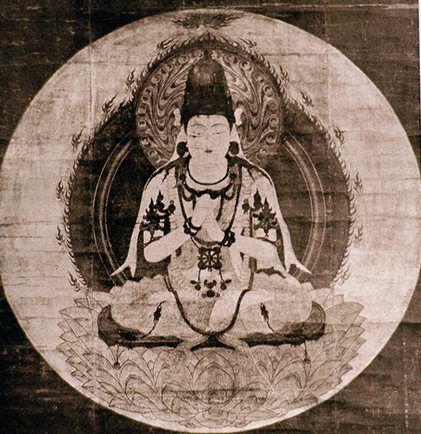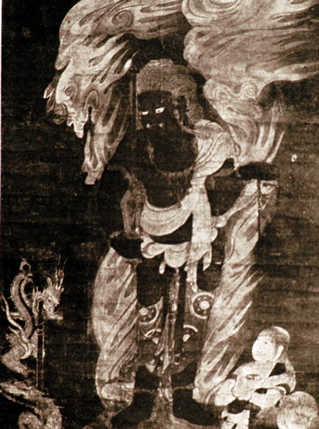Buddhist Ideals and Art
 He who adores the Divinity which is the consummation of his ideals and the source of inspiration and consolation, is realizing the spirit of that Divinity in his own soul, because his soul is in communion with, and inspired by, the Divinity.
He who adores the Divinity which is the consummation of his ideals and the source of inspiration and consolation, is realizing the spirit of that Divinity in his own soul, because his soul is in communion with, and inspired by, the Divinity.
The GREAT PASSION, Japanese, Early Fourteenth Century
This deity symbolizes the passions which, left to themselves, are sources of vice, but when controlled are sources of the power to strive for definite aims. His expression is fierce and strong. He has three pairs of arms carrying, respectively, a lotus and a stick with which to strike the wicked; a bow and arrows with which to attack human passions; a five-pointed vajra and a bell, with which to awaken all sentient beings to self-consciousness and lead them to reflection.
Buddha is the perfect person who attained the life of all-embracing wisdom and love, thus identifying himself with the cosmos and all the lives in it. The final substratum of Buddhahood is, therefore, the cosmos, including its spiritual and material aspects, and Buddha is the Lord who rules it, not from above, but from within. His spirit is the cosmic soul which, like a seed, evolves out of itself all the phenomena of the universe. The cosmic life thus regarded as the enactment of the infinite communion ruled by Buddha, the Cosmic Soul, may be and must be grasped and experienced by the soul which lives the life not of an individual but of the whole communion ; and this soul, when it transcends the limit of selfish narrowness and individuality, can include all existences within its domain, and discover in itself the germs of all phenomena. This means also an expansion of individual life to the compass of the universe, by hving in communion and participation with the cosmic life.
Viewed in this way, the beings and things of the world exist in order to realize their participation in the omnipresent activities of the Lord, and to live, think and express themselves as He does. We human beings, furnished with body and mind, are a concrete manifestation of the whole cosmic structure, and are destined to represent the cosmic life in personal life; but being shrouded in illusion and selfishness we have lost sight of the inner tie which unites us with the Great Illuminator, and of our real communion with other beings. It is, therefore, the purpose of Buddha in his innumerable manifestations as various deities and phenomena, to enlighten us in regard to our original kinship with him and in our destiny to restore it, so that we may achieve a full participation in the cosmic life.
Sweeping over Central Asia and China, and later reaching Japan at the beginning of the ninth century, Buddhism succeeded in absorbing the pantheons of these different peoples into its cosmotheistic domain and in uniting them with the central conception of a cosmic Lord, the Great Illuminator (Sanskrit, Maha-Vairochana; Japanese, Dai-nichi), a former title of Buddha which was now specified as a distinct personality.
The special tenet of Buddhism consists in showing us these educative activities of Buddha in concrete representations of his virtues and powers.
This is done by visualizing in pictures, statues and rites the symbolic or anthropomorphic manifestations of Buddha and the various deities which are his emanations. The Great Illuminator, for instance, is sometimes represented as a golden Buddha sitting on a red or variegated lotus flower, his ha nds folded in the posture of profound contemplation; again, he appears as a Buddha perfectly white in body sitting on a white lotus and expressing in his joined hands his intention of revealing truths.
Dai-nichi,  the Great Illuminator Artist unknown Japanese, Thirteenth Century
the Great Illuminator Artist unknown Japanese, Thirteenth Century
In the Museum of Fine Arts , Boston In this work of the middle Kamakura period the deity appears as Ichiji-kinrin, a supreme manifestation of Dai- nichi shown in the upper middle square of the Diamond Cycle, as indicated by the characteristic aureola and the whitish tone on both aureola and figure. Painted in colors on silk and mounted as a kakemono
He is shown also in a formidable aspect sitting or standing, his whole person expressive of resentment and indignation. In this guise he is called the Immobile and his fierce eyes glare at every evil thought or base passion, while the sword and rope he holds signify his readiness to menace and restrain every sinful act. 
FUDO AND HIS ATTENDANTS, Artist unknown Japanese, Kamakura Period, Thirteenth Century In the Museum of Fine Arte, Boston. A fierce manifestation of a Cosmic Lord, the Great Illuminator holding a sword and a rope in his hands and surrounded by flames. He is accompanied by two attendants, the boyish Konkara and the elderly Seitaka, representing respectively the sustaining virtue and the subjugating power of Fudo. The dragon on the left of the picture is called Kurikara, and is believed to represent either the subjugating power of Fudo, or the human passions which are to be subjugated by the symbolic sword round which the dragon is coiled. Painted in colors on silk and mounted as a kakemmo.

 email
email He who adores the Divinity which is the consummation of his ideals and the source of inspiration and consolation, is realizing the spirit of that Divinity in his own soul, because his soul is in communion with, and inspired by, the Divinity.
He who adores the Divinity which is the consummation of his ideals and the source of inspiration and consolation, is realizing the spirit of that Divinity in his own soul, because his soul is in communion with, and inspired by, the Divinity.  the Great Illuminator Artist unknown Japanese, Thirteenth Century
the Great Illuminator Artist unknown Japanese, Thirteenth Century